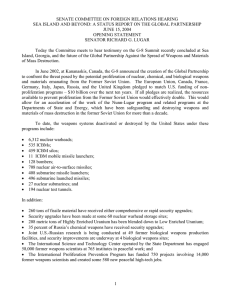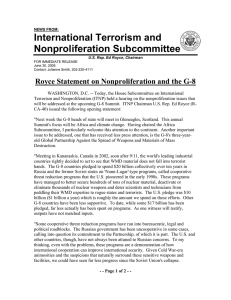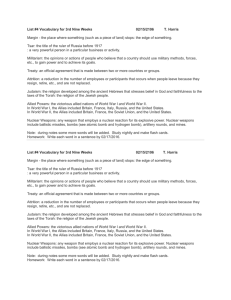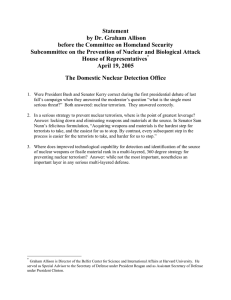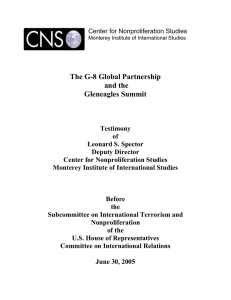TESTIMONY BY UNDER SECRETARY OF STATE FOR ARMS CONTROL AND INTERNATIONAL SECURITY
advertisement
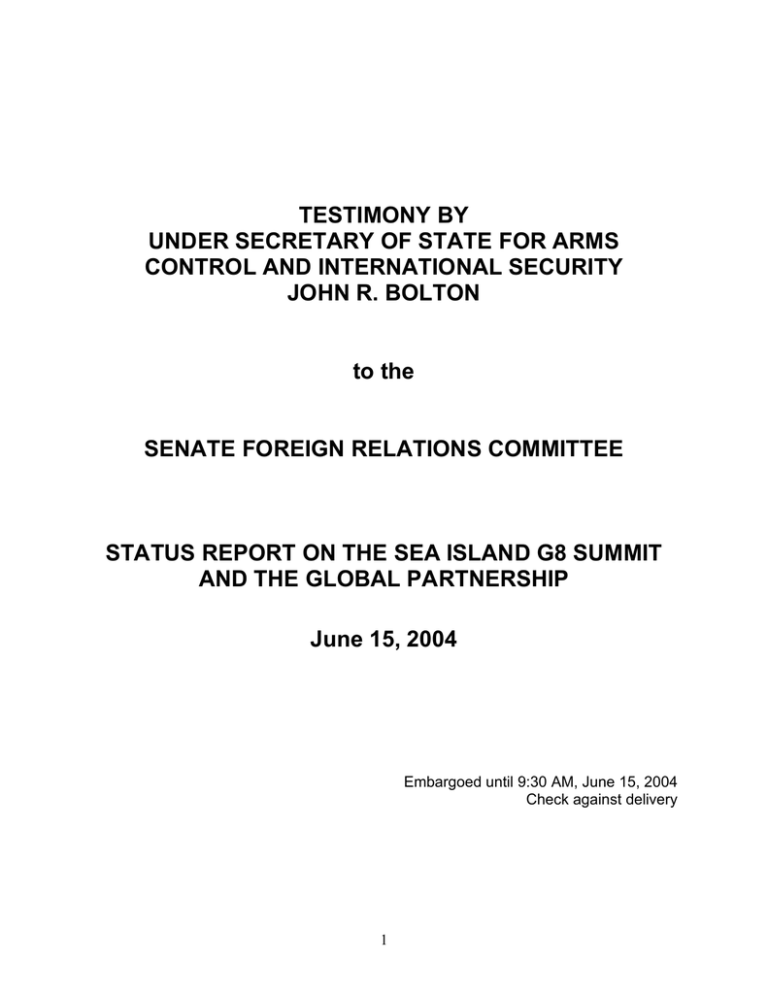
TESTIMONY BY UNDER SECRETARY OF STATE FOR ARMS CONTROL AND INTERNATIONAL SECURITY JOHN R. BOLTON to the SENATE FOREIGN RELATIONS COMMITTEE STATUS REPORT ON THE SEA ISLAND G8 SUMMIT AND THE GLOBAL PARTNERSHIP June 15, 2004 Embargoed until 9:30 AM, June 15, 2004 Check against delivery 1 Mr. Chairman and Members of the Committee, thank you for the opportunity to appear before the Committee today to discuss our progress on the United States’ nonproliferation agenda. I will report in some detail on the significant achievements at the G-8 Summit at Sea Island last week. President Bush set out the next steps in the Administration’s nonproliferation agenda in a comprehensive speech on February 11 of this year at the National Defense University. He made a number of specific proposals that formed the core of the United States approach at the Sea Island Summit. The President clearly highlighted the nightmare scenario presented by the possibility of terrorists or their state sponsors acquiring weapons of mass destruction (“WMD”), which would have no hesitation in using against civilian targets. The danger the President addressed is not new, and this Committee and its Chairman have been in the forefront of international efforts designed to reduce the risk that such a horrific event might ever occur. It is a testimony to the vision of this Committee's leadership that the Nunn-Lugar Cooperative Threat Reduction legislation dates to 1991, when the collapse of the Soviet Union left a legacy of awesome weapons at the mercy of chaotic events and vulnerable to loss, theft or misuse. The work that has been accomplished under that legislation has gone a long way towards preventing hostile states and terrorists from acquiring such weapons. It has helped transform a relationship of mutual hostility into one of cooperation. Rising to the occasion of an emergency response to crisis, our CTR programs have expanded in scope and enlisted the cooperation of friends and allies from around the world. Indeed, it is impossible to conceive of the Global Partnership as it now stands, without a clear line of paternity leading back to Nunn-Lugar over a decade ago. It is also a credit to the vision of your leadership, Mr. Chairman, that we cannot rest on the accomplishments of these programs thus far. Significant though they are, there is still a great deal of work to be done to move forward on the task that was begun over a decade ago. Let me describe what the Sea Island Summit committed us to accomplishing over the next decade. 2 The President's Speech and the Sea Island Summit 1. On February 11, the President recalled that he had proposed during his address to the UN General Assembly that the United Nations Security Council adopt a new resolution requiring all states to criminalize proliferation, enact strict export controls, and secure all sensitive materials within their borders. As you know, the Security Council unanimously passed The G-8 Partners commended this resolution on April 28th. Resolution 1540 as follows in the Sea Island Action Plan on Nonproliferation: “We strongly support UN Security Council Resolution 1540, calling on all states to establish effective national export controls, to adopt and enforce effected laws to criminalize proliferation, to take cooperation action to prevent non-state actors from acquiring weapons of mass destruction, and to end illicit trafficking in such weapons, their means of delivery, and related materials. We call on all states to implement this resolution promptly and fully, and we are prepared to assist them in so doing, thereby helping to fight the nexus between terrorism and proliferation, and black markets in these weapons and related materials.” A copy of the Sea Island G-8 Action Plan on Nonproliferation is attached to this testimony. 2. The Proliferation Security Initiative (“PSI”) passed its first anniversary last month. On May 31-June 1, the Government of Poland hosted an important conference of nations supporting PSI in Krakow, Poland, where the President first announced the initiative to address the growing challenge of weapons of mass destruction proliferation. It was gratifying to see so many countries -- sixty-two in all -- represented at this anniversary, and we know of other supporters who could not attend. We like to say that “PSI is an activity, not an organization,” and we believe this spirit and flexibility are among the keys to PSI’s success. In developing PSI, our main goal has been a simple one -- to create the basis for practical cooperation among states to help navigate the increasingly challenging arena of proliferation. Our goal is based on an equally simple tenet -- that the impact of states working together in a deliberately cooperative manner would be greater than states acting alone in an ad hoc fashion. 3 This past year, we learned just how far proliferation networks had advanced. PSI addresses that threat. And President Bush proposed in February that the work of PSI be broadened beyond interdicting shipments and transfers, to include greater cooperation in law enforcement. Our G-8 partners backed us at Sea Island. All eight participants reiterated their commitment to PSI and its Statement of Interdiction Principles as a global response to a global problem. The G-8 Nonproliferation Action Plan spoke in detail to PSI activities: “We will further cooperate to defeat proliferation networks and coordinate, where appropriate, enforcement efforts, including by stopping illicit financial flows and shutting down illicit plants, laboratories, and brokers, in accordance with national legal authorities and legislation and consistent with international law. Several of us are already developing mechanisms to deny access to our ports and airports for companies and impose visa bans on individuals involved in illicit trade.” 3. President Bush also made a bold and sweeping proposal to address the problem of proliferant states seeking nuclear weapons under false pretenses. Several countries have pursued programs to produce weapons-grade nuclear material under cover of civilian nuclear programs, while asserting a right under NPT Article IV to pursue sensitive nuclear technologies, such as enrichment and reprocessing. President Bush proposed closing that loophole in a manner that allows for the safe development of peaceful nuclear power programs without adding to the danger of weapons proliferation. The President called on all members of the Nuclear Suppliers Group (“NSG”) to refuse to sell enrichment and reprocessing technologies to any state that does not already possess full-scale, functioning enrichment and reprocessing plants. At Sea Island, the G-8 leaders recognized the danger of the spread of enrichment and reprocessing technologies and made a commitment to put in place by the time of the G-8 Summit next year specific measures to close this loophole while allowing the world to safely enjoy the benefits of peaceful nuclear energy. For the next year, the G-8 leaders agreed to refrain from new initiatives involving transferring enrichment and reprocessing technologies to additional states, and called on other states to adopt the same approach. Over the next year we will work to achieve the President’s objective of staunching the indiscriminate spread of these sensitive technologies. I spoke 4 to the NSG’s annual plenary session in Goteborg, Sweden last month, where I urged the other members to work with us to close this loophole in the nuclear nonproliferation regime. The endorsement of the G-8 leaders is an important step in this effort. 4. The Sea Island Summit also gave strong support to the President’s proposals concerning the IAEA Additional Protocol. The President proposed that, by next year, only states that have signed the IAEA Additional Protocol be allowed to import equipment for their civilian nuclear program. We have introduced that proposal into the NSG, urging amendment of the Nuclear Suppliers Guidelines to make the Additional Protocol a condition of supply for all “trigger list” items. In the G-8 Action Plan on Nonproliferation, the leaders urged all states to ratify and implement the Additional Protocol as soon as possible and said that the Additional Protocol “must become an essential new standard in the field of nuclear supply arrangements. We will work to strengthen NSG guidelines accordingly. We aim to achieve this by the end of 2005.” Implementing this agreement, we believe, would achieve the President’s goal. 5. The President also affirmed that we must ensure that the International Atomic Energy Agency (“IAEA”) is organized to take action when action is required. To this end, he suggested two steps to strengthen IAEA governance: the creation of a Special Committee of the IAEA Board of Governors to focus intensively on safeguards and verification, and second, that countries under investigation for violating nuclear nonproliferation obligations should be precluded from serving on the IAEA Board or the new Special Committee. These proposals drew close interest from our G-8 partners. We found much agreement with the idea that safeguards and verification need more concerted attention. At Sea Island, the G-8 leaders endorsed this approach: “To enhance the IAEA’s integrity and effectiveness, and strengthen its ability to ensure that nations comply with their NPT obligations and safeguards agreements, we will work together to establish a new Special Committee of the IAEA Board of Governors. This committee would be responsible for preparing a comprehensive plan for strengthened safeguards and verification. We believe this committee should be made up of member states in compliance with their NPT and IAEA commitments.” G-8 partners also agreed with the principle, as the President expressed it, that those actively breaking the rules 5 should not be entrusted with enforcing the rules. To this end, we sought to limit the opportunity for IAEA Board members, which are in violation of their nonproliferation obligations, to act on Board business that addresses their own violations. At Sea Island the G-8 leaders endorsed recusal of countries under investigation from decisions regarding their own cases. This is a step forward, although more needs to be done on this point. These issues will be addressed at the IAEA Board of Governors meeting that began yesterday, June 14. We will be raising the question of the Special Committee, and the question of denying Board and Special Committee membership to those in violation of their nonproliferation obligations. We will describe terms of reference for the Special Committee, with attention to how we can better understand, and respond to, trade in black market equipment and technology. We will urge the IAEA to use the full breadth of its authorities to verify declared activities, and to ferret out undeclared nuclear activities. Each and every one of the foregoing initiatives reinforces the Global Partnership, to which I now turn. Global Partnership At their June, 2002, Summit in Kananaskis, G-8 Leaders pledged to raise up to $20 billion to be spent over ten years for nonproliferation, disarmament, counter-terrorism, and nuclear safety projects in the states of the former Soviet Union. This commitment attempts to prevent terrorists or states that support them from acquiring or developing weapons of mass destruction (“WMD”), missiles, and related materials, equipment and technology. The Global Partnership accomplished a great deal in the past two years, making progress towards its commitment to raise up to $20 billion, expanding participation, laying solid groundwork for cooperation, advancing current programs, and launching new projects. This United States initiative attempts to leverage our G-8 partners to match our own billion-dollarper-year programs. To date, the seven other G-8 states and the European Union have pledged about $6.5 billion. In addition, Russia plans to spend $2 billion of its own funds. Six new donors that joined in 2003 -- Finland, the Netherlands, Norway, Poland, Switzerland, and Sweden -- have committed about $210 million. Concrete results are now appearing in projects underway or about to begin with funding mobilized from the Partnership. The United States considers the $20 billion goal of the Global 6 Partnership to be a floor and not a ceiling. We made this position quite clear at Kananaskis and subsequently, and more recently in the President’s February NDU speech. We hope to persuade our G-8 colleagues to consider it the same. Another component of President Bush's initiative was to expand the Global Partnership to involve additional donor countries. Last week, at the Sea Island Summit, G8 Leaders welcomed seven new donor countries: Australia, Belgium, the Czech Republic, Denmark, Ireland, the Republic of Korea, and New Zealand. While many of these new donors are in the early stages of the process of designating funds and considering projects, they nonetheless increase the Global Partnership's political impact, and broaden its capability to make it a truly global effort to prevent the proliferation of weapons and materials of mass destruction. President Bush also proposed expanding the Global Partnership to new recipient countries. The United States has substantial nonproliferation projects underway in several former Soviet states, which count toward our Global Partnership pledge, as have some other G-8 countries. We are actively encouraging the G-8 to accept new recipient countries such as Ukraine, Kazakhstan, Uzbekistan, and Georgia, and will continue to do so. We discussed participation with Ukraine, and will do so with other former Soviet states. At Sea Island, the G-8 took an important step to make the Global Partnership truly global, agreeing to use the Global Partnership to coordinate efforts to address proliferation challenges worldwide. For example, we will pursue the retraining of Iraqi and Libyan scientists involved in past WMD programs. Through the launch of the Global Partnership initiative the leading industrialized countries of the G-8 committed to greatly expanded nonproliferation cooperation, that far exceeds their engagement in the preceding ten years. Some have criticized the progress made to date in implementing these commitments. However, many donor countries started from scratch to negotiate implementing agreements with Russia that include essential sound business practices such as tax exemption, access to work sites, and transparency in financial transactions. For example, Canada and Russia signed at Sea Island last week a bilateral agreement that will allow Canada’s projects in Russia to go forward; this welcome step required negotiations that began shortly after Kananaskis and took two years to complete. Unfortunately, the work of putting in place the necessary agreements, which requires close coordination and support from the recipient 7 countries, has taken longer than we would like, as does the development of sound project designs that will ensure that taxpayer money does not go to waste. I can assure you that donor countries are readily pressing for timely conclusions of these arrangements. Since the U.S. already had implementing frameworks in place, we have forged ahead. The United States is on track in fulfilling its $10 billion pledge, with annual funding commitments at about $1 billion. The planned United States activities will represent a substantial increase over the preceding 10 years' efforts. The $10 billion pledged from June 2002 through 2012 will be some $3 billion greater than the United States spent on nonproliferation efforts from 1992 to June 2002. Our funding commitments are being translated into concrete actions as considerable amounts of funds are flowing to Global Partnership projects. Global Partnership cooperation spans the full range of nonproliferation and nuclear safety cooperation. I am submitting for the record the G8 Global Partnership's Annual Report and annex, the Consolidated Report of Global Partnership Projects, which provide a record of Global Partnership activities and project commitments to date. These reports were released by the G8 Leaders last week at the Sea Island Summit, and are available on the Sea Island web site. The reports reflect funding since the establishment of the Global Partnership in 2002. Thus, U.S. FY 1992-2002 funding of almost $7.2 billion for nonproliferation and threat reduction programs in the former Soviet Union are not included therein. The broad level of support for the Global Partnership goals is reflected in the wide degree of participation in the Global Partnership projects. My colleagues from the Departments of Energy and Defense will elaborate on their agencies’ significant work and accomplishments, including in the areas of nuclear and radioactive materials security, chemical weapons destruction, bio-security and bio-safety, and redirection of former weapons scientists. It is worth noting that these efforts enjoy a substantial degree of support from other Global Partnership participants. Chemical weapons (CW) destruction. Russia’s stockpile of 40,000 metric tons of chemical weapons -- the largest in the world by far -- is a substantial security concern. We need only think back to the 1995 attack by the Japanese cult Aum Shinrikyo on the Tokyo subway system to recall the consequences of terrorist use of chemical weapons. Canada, the European Union, Finland, France, Germany, Italy, the Netherlands, 8 Norway, Poland, Russia, Switzerland, and the United Kingdom are committed to projects assisting Russia at sites including Gorny, Shchuch'ye, Pochep, and Kambarka. Russia is responsible for fulfilling its obligations under the Chemical Weapons Convention to destroy its CW stockpiles, but assistance provided by Global Partnership partners will substantially facilitate and accelerate the destruction of CW in Russia. The U.S. is by far the largest donor in this project, with funding over $830 million since 1992, mostly for the nerve agent destruction facility at Shchuch’ye. Nuclear submarine dismantlement. The United States is completing a multiyear effort to dismantle Russian decommissioned strategic nuclear submarines, with $372 million funded to date. In addition, to assist our Global Partnership colleagues, we have authorized the use of equipment belonging to the U.S. program by other countries to dismantle Russia's general-purpose nuclear-powered submarines. Under the Global Partnership, Canada, the European Union, Finland, France, Germany, Italy, Japan, the Netherlands, Norway, Sweden, and the United Kingdom are or will soon be providing substantial contributions for nuclear submarine dismantlement and related activities for the safe handling and storage of their associated nuclear and radioactive waste. Securing nuclear materials. Disposing, securing and preventing the further production of fissile materials is key to our global efforts to keep terrorists or threatening states from acquiring or manufacturing a nuclear weapon. This area is a priority for the United States, Canada, the European Union, Finland, Germany, Norway, Sweden, and the United Kingdom. DOE has for some time been engaged in a high-priority effort to increase the protection of nuclear material in Russia. To date, with U.S. assistance, approximately forty-five percent of fissile material in Russian is secure. By 2008, Russia and the U.S. plan to have all fissile material facilities secure. Funding for these programs has increased 50% over the last four years from $622 million (for FY96-00) to $928 million (for FY O1-04). DOD has recently completed the construction and certification of the fissile material storage facility at Mayak in Russia. This modern and highly secure facility will allow Russia to consolidate and safely store more than 25 tons of Russian plutonium from their nuclear weapons program. 9 In addition, Secretary Abraham announced the Global Threat Reduction Initiative (“GTRI”) on May 26. We are committing over $450 million to GTRI. Its overall objective is to secure, remove or dispose of a broad range of nuclear and radiological materials around the world that are vulnerable to theft. Important components of the program are to repatriate U.S. and Russian-origin research reactor fuel, and to convert research reactors from HEU to LEU. In his announcement Secretary Abraham committed the United States to return all fresh Russian-origin HEU material to Russia by the end of 2005, and to complete the repatriation of all Russian-origin spent fuel by 2010. On the following day the United States and Russia signed an implementing agreement that will permit this program to move forward with accelerated fuel shipments from Russian-origin research reactors in at least 12 countries. Increasing the Security of Russian Nuclear Warheads. There are also ongoing efforts by the Departments of Defense and Energy to increase the security of Russian nuclear warhead facilities. Considerable effort has been devoted to difficult access issues for these sensitive facilities and work is now ongoing in order to increase the security of warhead storage sites throughout Russia. My DOE colleagues will have more to say about these programs. Securing Dangerous Pathogens. Cooperative bio-security and bio-safety projects in the former Soviet Union, including securing dangerous pathogens, are being pursued not only by the U.S. but also by France and Sweden. The DOD biosecurity programs are aimed at increasing the safety and security of dangerous pathogen collections in Russia, Kazakhstan, Uzbekistan, and Georgia. Meanwhile, we are working with these countries to become partners in global efforts to prevent biological terrorism. Funding for this program is $54 million for FY 2003 and FY 2004. Redirection of former weapons scientists. One of the biggest proliferation challenges we face today is preventing the spread of the knowledge and expertise necessary to make weapons of mass destruction. A key priority for the United States is to redirect former weapons scientists to productive civilian employment so they do not leave to work for terrorist groups or dangerous states. These programs share a common strategy: to access high-risk former weapon institutes and to help them "graduate" into self-supporting, transparent civilian endeavors. Besides the United States, the European Union, individual European states, the United Kingdom, and Canada are working to implement several programs to engage WMD scientists. 10 The United States is engaged in the permanent redirection of former weapon scientists worldwide through long-standing programs such as the Science Centers and Bio-Chem Redirection programs. Newer efforts are underway, such as the scientist redirection initiatives in Iraq and Libya and the Bio Industry Initiative in Eurasia. Improving Export Control. Working with other governments to ensure that they have the necessary awareness, authorities, and capabilities to prevent transfers of proliferation concern is a critical component of nonproliferation objectives. We are continuing to expand our efforts to help other countries to bring their export control systems up to international standards. These efforts are what the president urged in his September 2003 speech to the UN General Assembly, and as now embodied in Security Council Resolution 1540, through our Export Control and Border Security (“EXBS”) program. While the EXBS program initially focused on the Former Soviet Union, the program has adapted to meet the changing proliferation threat. It is now active in over 30 countries, including potential WMD “source countries” in South Asia and in regions that are producers of weapons-related items and key transit and transshipment states in regions such as Southeast Asia, the Middle East, the Mediterranean and Central Europe. The EXBS program draws on expertise from a number of U.S. agencies and private contractors to provide training and equipment to address all areas of a comprehensive export control system. For example, through the EXBS program we have helped other countries draft and pass new export control laws, establish special customs enforcement teams, improve inspection/detection capabilities that have led to seizures of suspect shipments at border crossings, and screen license applications and cargo shipments for transfers of proliferation concern. We have also placed EXBS program advisors at our Embassies in a number of countries to help implement the program and coordinate with the efforts of other programs and governments. Stopping Nuclear Material Smuggling. We are working closely with our allies to detect, track, and prevent nuclear material smuggling. Furthermore, we encourage governments to prosecute those involved and to take steps to protect WMD material. The IAEA Illicit Trafficking Database Program, in which we participate, contributes to our efforts to combat smuggling by having governments confirm illicit trafficking. This program will help member countries verify sometimes incomplete press reporting of illicit trafficking as well as allow better follow 11 up on nuclear and radiological material that is not appropriately controlled. Access. Access to sensitive Russian facilities has been a significant issue. Indeed, at the time of the Kananaskis Summit, several of our G-8 partners reported that lack of access was a major factor preventing the implementation of significant programs in the Russian Federation. One of our major objectives in implementing the Global Partnership was to break through these barriers. Today, we conclude substantial progress has been made toward this major objective. For the vast majority of facilities where cooperative work is ongoing, we have sufficient access to perform both security upgrades and audit such work after completion. There are, however, a few nuclear facilities that are so sensitive to the Russians that they have been reluctant to provide the access necessary to pursue cooperative projects to increase their security. NDF. The State Department's Nonproliferation and Disarmament Fund (“NDF”) continues to take advantage of unanticipated opportunities to tackle unusually difficult and high priority projects. The NDF is particularly useful in our efforts in both Libya and Iraq. Most recently, NDF assisted State and Energy officers with the packaging and shipping of more than 1,500 tons of centrifuge parts, nuclear material and related items from Libya, completely removing its uranium enrichment program. NDF has also supported the redirection of former Iraqi WMD scientists, technicians and engineers to civilian employment. This redirection effort is a critical program that prevents the global spread of weapons expertise and helps rebuild Iraq. Other less high profile, but significant projects, that benefit from NDF funds and guidance are the ongoing dismantling of the BN-350 reactor in Kazakhstan and security upgrades of sensitive WMD sites in the Balkans. Faced with persistent areas of concern, we will continue to deploy NDF as a critical tool to halt the proliferation of nuclear, biological, chemical and advanced conventional weapons. Conclusion As you see, the Global Partnership encompasses a wide variety of projects. These projects are funded by 21 countries and carried out in Russia and a number of other states. The Global Partnership oversees coordination of these projects in order to take advantage of each other’s experience, avoid duplication and overlap, and steer donor countries towards uncovered priority needs. As the pace of project activities increases and the number of participating countries grows, the importance of this coordinating function will increase. 12 While a great deal remains to be done, the Global Partnership is making good, steady, financially sound progress toward the goal of implementing projects that will keep weapons and materials of mass destruction out of the hands of those who would do us harm. Mr. Chairman, we believe that the Sea Island Summit, and the G-8 Action Plan on Nonproliferation will be important milestones in the fight against the spread of weapons of mass destruction. We look forward to working with you and other members of this Committee. Thank you again for the opportunity to testify here today, and I look forward to answering your questions. 13


